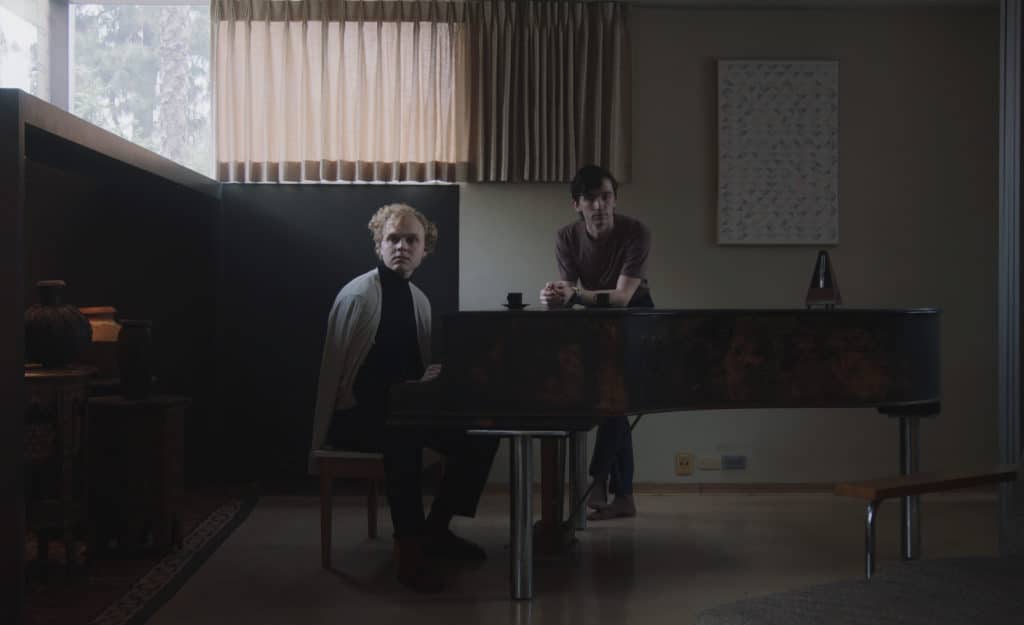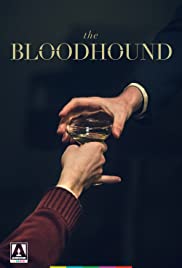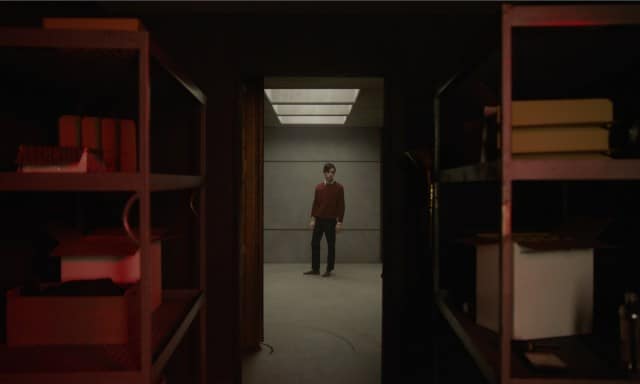
If ever you’ve wondered, deep in your heart, what an experimental/arthouse spin on The Fall of the House of Usher would look like, then wonder no further: The Bloodhound explores similar themes of warped family dynamics, fatalism and isolation, though by coming at it in an ultra-modern location with a low-exposition, dialogue-lite story. A first feature film by director Patrick Picard, this clearly isn’t the style of film you make by accident. Accordingly, I don’t know whether to applaud his single-mindedness, or ask more questions.
As per House of Usher, a young man, Francis (Liam Aiken) arrives at a large house after hearing from his old friend Jean-Paul (Joe Adler), who wrote him a note requesting his company. He’s a little perturbed by the front door standing wide open, but he’s soon reunited with J.P. and they talk…warmly? They talk. And, as they talk, it’s revealed that these two haven’t seen each other in a decade. J. P. reached out in a fit of loneliness; it seems he’s been labouring under various neuroses, alongside his hitherto-unseen twin sister, Vivian (Annalise Basso). If anything, J. P. explains, Vivian is even worse. It’s a strange set-up, but Francis agrees to stay.
It’s quite a house – that kind of vast, minimalist space which always makes me side-eye my stacks of books and papers a little guiltily – and it soon has an impact on Francis which makes him feel as disorientated as his companion seems to be. The divide between sleeping and waking becomes blurry here; J. P. seems to encourage this confusion, but then again, it’s never truly made clear whether the house does have some sort of life beyond itself which has an impact on its inmates, or if it’s all the inmates. Events take a turn when J. P. reveals that he’s had all of Francis’s worldly possessions brought out of storage and to the house, without being asked to do it. Curiouser and curiouser. The two men’s relationship seems to grow more off-key, with more questions than answers, and it’s unclear who’s duping who; meanwhile, Vivian remains an unseen, intangible presence in this place.

The Bloodhound is what I’d call ‘a peculiarity’. It’s languid, it never gives us any denouement and as such, it’s quite difficult to call it a narrative as such. Tantalising hints – the symbolism of ‘the bloodhound’ himself – are quite easily explained away in the end, whereas the conversations between Francis and J. P. never seem to reveal very much at all. There’s nothing naturalistic about the way they talk and what they say is, essentially, the entire film: high in the mix, the speech dominates the rest of the sound design. So it’s dialled up, but also quite ponderous, even turgid. Again, this was obviously a directorial decision, and I rather wonder if Picard was going for the kind of stylised conversation which you often encounter in arthouse cinema. Fair enough, if so. This kind of thing isn’t for everyone, and it pushed my tolerance in places. Probably the film’s most interesting aspect is in how it questions whether, in these hyper-connected times where a person has access to everything they could ever need, a person could ever again be as cut off as, let’s say, the Ushers. And of course, they can: J.P.’s rationale for never leaving the house comes at least partly from the horrors which he hears on the news; he talks a few times about ‘connectivity’, even though he eschews it. We never see anyone here accessing the internet or similar, but it’s clearly there.
There’s no doubt that The Bloodhound is an attractive film with a keen eye for attractive shots and lighting. The two male leads do fine, albeit they are not given a tremendous amount with which to grapple, and it’s a shame that actress Annalise Basso is more or less absent (though, yes, I get it). This is, though, primarily a dour mood piece, and your engagement with it will likely come in large part from your knowledge of and your enjoyment of Poe.
The Bloodhound is available now on Arrow.
